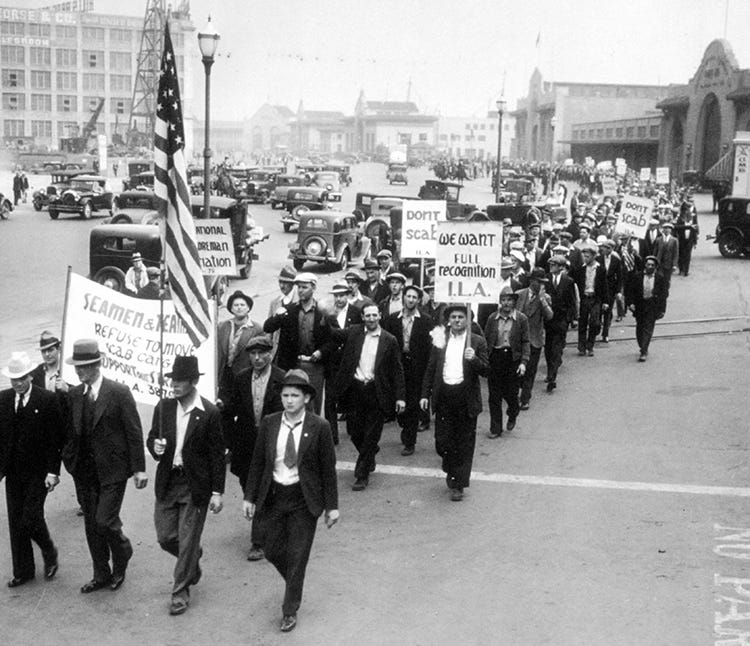Radical Responses to the Great Depression
The Labor History Corner--an excerpt from From Mission to Microchip: A History of the California Labor Movement By Fred Glass
A version of this article appeared on the California Labor Federation California Labor History website. You can buy From Mission to Microchip: A History of the California Labor Movement from the University of California Press.

The Great Depression lasted for a dozen years, threw tens of millions of people into hard times, and transformed the country in fundamental ways. Its early years produced mass misery and despair, but also radical social movements that channeled desperation into collective action. In the fall of 1933, the Cannery and Agricultural Workers Industrial Union, led by Communists, helped farm laborers conduct the biggest strike in central valley history.
At the same moment but a hundred miles south, anarchist organizer Rose Pesotta assisted immigrant Russian Jews and Mexicans to unionize Los Angeles garment sweatshops. The following year, a few months after the San Francisco General Strike, when striking maritime workers led by longshoreman Harry Bridges expanded their job action until the entire city was shut down for four days, Socialist novelist Upton Sinclair scared the daylights out of ruling elites when working class voters almost elected him California governor on a platform of “production for use.” Pushed by events, organizations, people and political ideas like these, the federal government improved and strengthened a “New Deal” to fix the economy and put people back to work.
End Poverty in California
Encouraged by signs that large sections of the working class were beginning to stir, Upton Sinclair thought the New Deal might address some of the problems he saw around him in the Golden State; but he did not think it would cure the Depression entirely, nor was he inclined to wait patiently for this to happen. Instead, the long time Socialist pamphleteer and best selling author of The Jungle and Oil! decided the time had come to run for governor—as a Democrat. In the biggest news for the California electoral left since Job Harriman’s run at the mayor’s office of Los Angeles in 1911, Sinclair won the Democratic nomination with more votes than anyone had ever received in a California primary. He seemed poised to win the election.
His plan, which he called “End Poverty in California,” or EPIC, was breathtakingly simple: to put the state’s unemployed (29% in 1933) to work by bringing them together in “cooperative colonies” in the empty factories and vacant fields dotting the economic landscape. They would trade the results of their labors with each other directly, without the intervention of money. The resultant “production for use” would replace production for profit and jumpstart a new economy. Two years before passage of the Social Security Act, Sinclair called for a pension for every needy person over 60, widows with children, and the disabled.
Sinclair wrote and published a booklet to popularize his ideas, I, Governor of California, and How I Ended Poverty: A True Story of the Future. His followers pulled together an impressive organization based around circulation and discussion of the pamphlet, which sold more than a quarter million copies. They launched hundreds of EPIC clubs, and ran a slate of candidates for the California legislature.
The heart of Sinclair&rsrsquo;s support was the huge span of industrial suburbs sprawling from downtown Los Angeles south to San Pedro and Long Beach, and working class neighborhoods in the other major cities. EPIC also benefited from the political journey of African Americans, now reaching a decisive moment thanks to the Depression. Historically Republican since Lincoln’s time, Blacks were switching allegiances in the 1930s as their party failed to come up with adequate responses to the economic crisis, which for them was magnified by racism restricting workforce participation to the bottom levels of employment. Sinclair’s plan made good sense to Augustus Hawkins, the first African American elected to the California Assembly, who ran as an EPIC candidate.
The Lie Factory
Unfortunately for Sinclair, EPIC also made sense to the organizations of the employing class—the same kind of sense they had made of Socialist Job Harriman’s campaign for mayor of Los Angeles two decades earlier. They funded what Sinclair called “the Lie Factory,” a ferocious assault on Sinclair’s ideas, character, and candidacy. The owners of the newspaper, radio and motion picture industries in California closed ranks to wage a furious media war, masterminded by a Los Angeles advertising firm. The campaign for incumbent Governor Frank Merriam virtually ignored its own candidate, running an all-negative onslaught targeting Sinclair. One low tactic among many others: short films, pretending to be documentary newsreels of “man in the street” reactions to Sinclair and his ideas, were shown in every movie theater in the state. Produced by the movie studio bosses, they were completely scripted and acted, including scenes of hoboes flooding into California in expectation of the good life after a Sinclair victory.
Beaten, the EPIC campaign nonetheless contributed important steps forward for California politics. It built a progressive pro-labor wing in the Democratic Party and elected dozens of its candidates to the Legislature, including future governor Culbert Olson, the first Democrat elected to California’s highest office in the twentieth century (1938). The ambitious scale of EPIC’s ideas helped Roosevelt’s policy advisors to think big (although the President refused to endorse Sinclair himself). It also provided a vision of industrial democracy that reverberated with workers waiting for an organization that could help them realize that idea.
Fred Glass is the author of From Mission to Microchip: A History of the California Labor Movement (UC Press, 2016) and a former member of the State Committee of California DSA
Stay tuned for next week’s installment…



